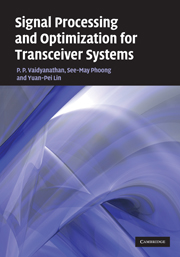Refine search
Actions for selected content:
6791 results in Communications and signal processing
10 - Carrier Recovery
- from Step 4 - The Adaptive Components
-
- Book:
- Software Receiver Design
- Published online:
- 05 June 2012
- Print publication:
- 18 August 2011, pp 192-225
-
- Chapter
- Export citation
6 - Sampling with Automatic Gain Control
- from Step 3 - The Idealized System
-
- Book:
- Software Receiver Design
- Published online:
- 05 June 2012
- Print publication:
- 18 August 2011, pp 98-129
-
- Chapter
- Export citation
Frontmatter
-
- Book:
- Software Receiver Design
- Published online:
- 05 June 2012
- Print publication:
- 18 August 2011, pp i-iv
-
- Chapter
- Export citation
A - Transforms, Identities, and Formulas
- from Appendices
-
- Book:
- Software Receiver Design
- Published online:
- 05 June 2012
- Print publication:
- 18 August 2011, pp 404-411
-
- Chapter
- Export citation
8 - Bits to Symbols to Signals
- from Step 3 - The Idealized System
-
- Book:
- Software Receiver Design
- Published online:
- 05 June 2012
- Print publication:
- 18 August 2011, pp 152-164
-
- Chapter
- Export citation
15 - Make It So
- from Step 5 - Putting It All Together
-
- Book:
- Software Receiver Design
- Published online:
- 05 June 2012
- Print publication:
- 18 August 2011, pp 342-356
-
- Chapter
- Export citation
F - The Ƶ-Transform
- from Appendices
-
- Book:
- Software Receiver Design
- Published online:
- 05 June 2012
- Print publication:
- 18 August 2011, pp 428-441
-
- Chapter
- Export citation
9 - Stuff Happens
- from Step 3 - The Idealized System
-
- Book:
- Software Receiver Design
- Published online:
- 05 June 2012
- Print publication:
- 18 August 2011, pp 165-190
-
- Chapter
- Export citation
Dedication
-
- Book:
- Software Receiver Design
- Published online:
- 05 June 2012
- Print publication:
- 18 August 2011, pp xiv-xiv
-
- Chapter
- Export citation
To the Instructor …
-
- Book:
- Software Receiver Design
- Published online:
- 05 June 2012
- Print publication:
- 18 August 2011, pp v-viii
-
- Chapter
- Export citation
7 - Digital Filtering and the DFT
- from Step 3 - The Idealized System
-
- Book:
- Software Receiver Design
- Published online:
- 05 June 2012
- Print publication:
- 18 August 2011, pp 130-151
-
- Chapter
- Export citation
5 - Analog (De)modulation
- from Step 3 - The Idealized System
-
- Book:
- Software Receiver Design
- Published online:
- 05 June 2012
- Print publication:
- 18 August 2011, pp 80-97
-
- Chapter
- Export citation
G - Averages and Averaging
- from Appendices
-
- Book:
- Software Receiver Design
- Published online:
- 05 June 2012
- Print publication:
- 18 August 2011, pp 442-450
-
- Chapter
- Export citation
13 - Linear Equalization
- from Step 4 - The Adaptive Components
-
- Book:
- Software Receiver Design
- Published online:
- 05 June 2012
- Print publication:
- 18 August 2011, pp 270-302
-
- Chapter
- Export citation
D - Relating the Fourier Transform to the DFT
- from Appendices
-
- Book:
- Software Receiver Design
- Published online:
- 05 June 2012
- Print publication:
- 18 August 2011, pp 421-424
-
- Chapter
- Export citation
Step 4 - The Adaptive Components
-
- Book:
- Software Receiver Design
- Published online:
- 05 June 2012
- Print publication:
- 18 August 2011, pp 191-191
-
- Chapter
- Export citation
C - Envelope of a Bandpass Signal
- from Appendices
-
- Book:
- Software Receiver Design
- Published online:
- 05 June 2012
- Print publication:
- 18 August 2011, pp 416-420
-
- Chapter
- Export citation
Step 3 - The Idealized System
-
- Book:
- Software Receiver Design
- Published online:
- 05 June 2012
- Print publication:
- 18 August 2011, pp 58-58
-
- Chapter
- Export citation
16 - A Digital Quadrature Amplitude Modulation Radio
- from Step 5 - Putting It All Together
-
- Book:
- Software Receiver Design
- Published online:
- 05 June 2012
- Print publication:
- 18 August 2011, pp 357-403
-
- Chapter
- Export citation

Signal Processing and Optimization for Transceiver Systems
-
- Published online:
- 05 August 2011
- Print publication:
- 11 March 2010
